So, you're curious about the Neapolitan Mastiff breed, huh? Well, get ready to be impressed. These majestic dogs have a rich history that dates back to ancient times, where they were renowned as loyal and protective guardians.
But there's more to these gentle giants than just their impressive lineage. From their massive size and distinctive coat to their affectionate nature and unique behavioral traits, Neapolitan Mastiffs are truly a breed like no other.
But what makes them stand out from the rest? Well, my friend, you're about to find out.
Key Takeaways
- Neapolitan Mastiffs are a large breed of dog originating from Italy, known for their size and weight.
- When choosing a dog for apartment living, size should not be the sole determinant – consider the dog's energy level and activity needs.
- Neapolitan Mastiffs are affectionate with their families, loyal, and protective, making them good companions.
- Factors to consider in dog behavior include prey drive, barking tendencies, wanderlust potential, and exercise needs.
Origin and History
The Neapolitan Mastiff, originating from Italy, has a rich history that dates back centuries. This majestic breed was initially developed as a guardian and protector of estates, as well as a formidable war dog. In ancient Rome, they were often used in gladiator battles, showcasing their strength and bravery.
Over time, the Neapolitan Mastiff's role evolved, and they became beloved family companions known for their loyalty and affection towards their owners. Despite their impressive size and powerful appearance, they're generally good with children and can be gentle and loving companions.
However, it's important to note that they may not be suitable for novice dog owners due to their strong-willed nature. The Neapolitan Mastiff's history is a testament to their enduring legacy as a breed that combines strength, loyalty, and love.
Size and Weight
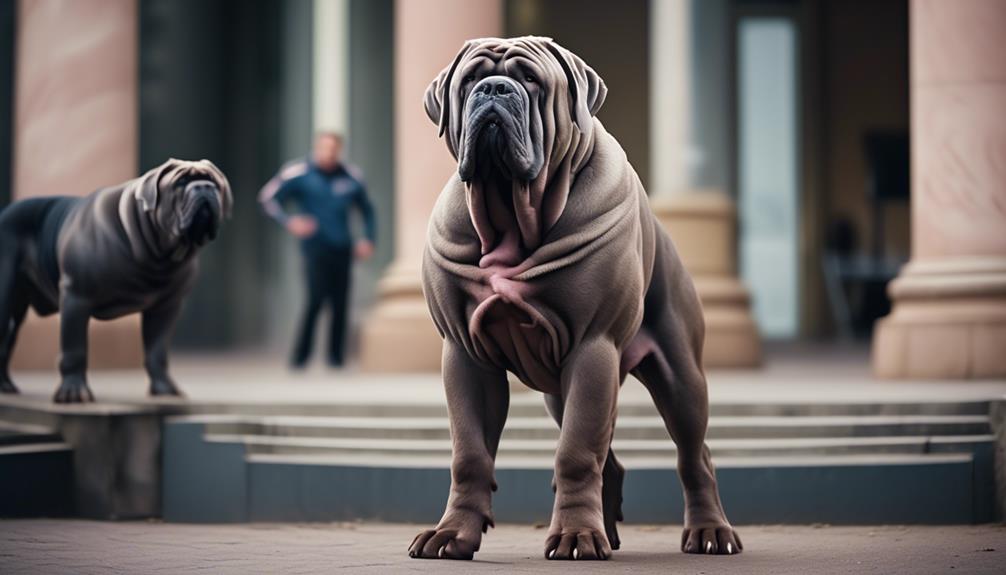
When considering the Neapolitan Mastiff, one can't overlook its impressive size and weight. This breed is known for its large stature, typically standing 26-31 inches tall at the shoulder. In terms of weight, Neapolitan Mastiffs are heavy dogs, weighing between 150-200 pounds.
Their massive build and muscular frame contribute to their imposing presence. It's important to note that this breed's size and weight can vary slightly, with some individuals being smaller or larger than the average range. However, regardless of the specific measurements, the Neapolitan Mastiff's sheer size commands attention and respect.
This characteristic, combined with their loyal and protective nature, makes them excellent guard dogs and a formidable presence to behold.
Breed Group Classification
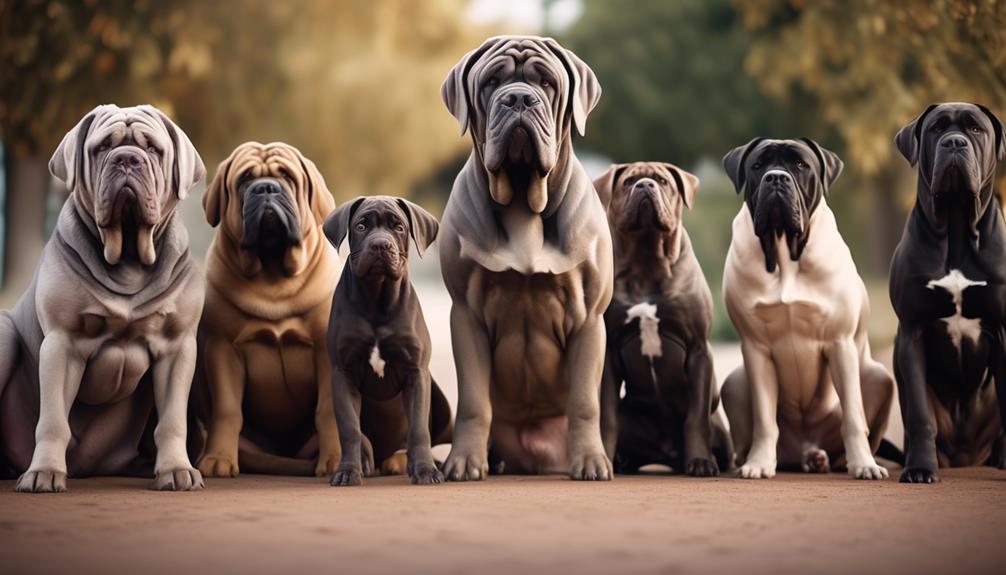
To understand the Neapolitan Mastiff's breed group classification, consider its working heritage and the traits associated with this group. The Neapolitan Mastiff belongs to the Working breed group, which is known for its strength, intelligence, and versatility.
Here are three key characteristics of the Working group:
- Strong and Powerful: Dogs in the Working group are bred to perform tasks that require strength and endurance. They're capable of pulling heavy loads, guarding property, and performing search and rescue operations.
- Intelligent and Trainable: Working dogs are highly intelligent and trainable, making them suitable for various types of work. They're quick learners and excel in obedience training and tasks that require problem-solving skills.
- Protective and Loyal: Dogs in the Working group are known for their loyalty and protective instincts. They're dedicated to their families and will go to great lengths to keep them safe.
The Neapolitan Mastiff embodies these characteristics, making it a true representative of the Working group.
Lifespan Expectancy
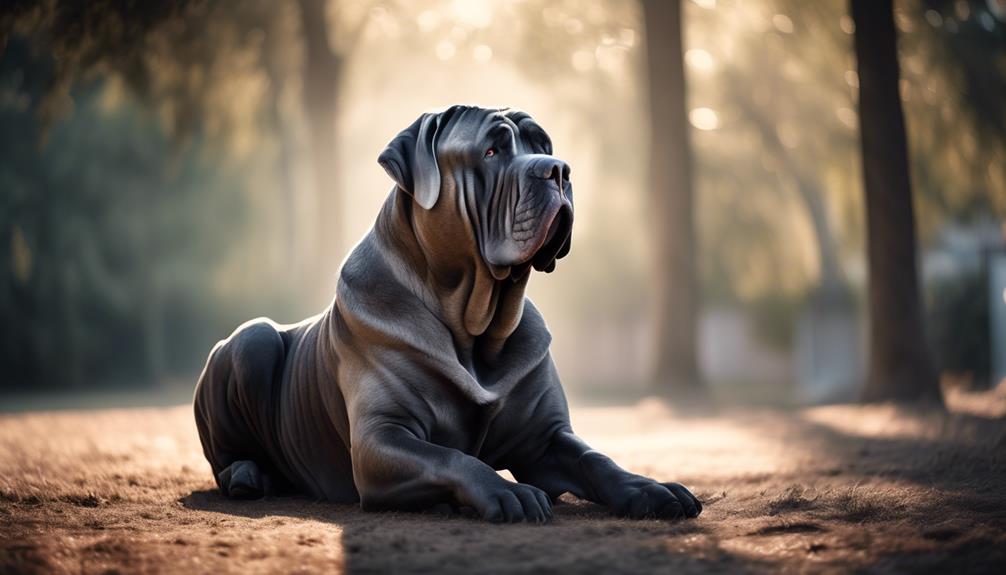
On average, Neapolitan Mastiffs have a lifespan of 8-10 years. This means that they can be considered a breed with a relatively short lifespan compared to other dog breeds. It's important to keep this in mind when considering adding a Neapolitan Mastiff to your family.
While they may not live as long as some other breeds, they can still bring years of joy and companionship. To ensure that your Neapolitan Mastiff lives a healthy and happy life, it's crucial to provide them with proper care, including regular vet check-ups, a balanced diet, and plenty of exercise.
Additionally, being aware of any potential health issues that are common in the breed can help you take proactive measures to keep your Mastiff in good health for as long as possible.
Coat Description
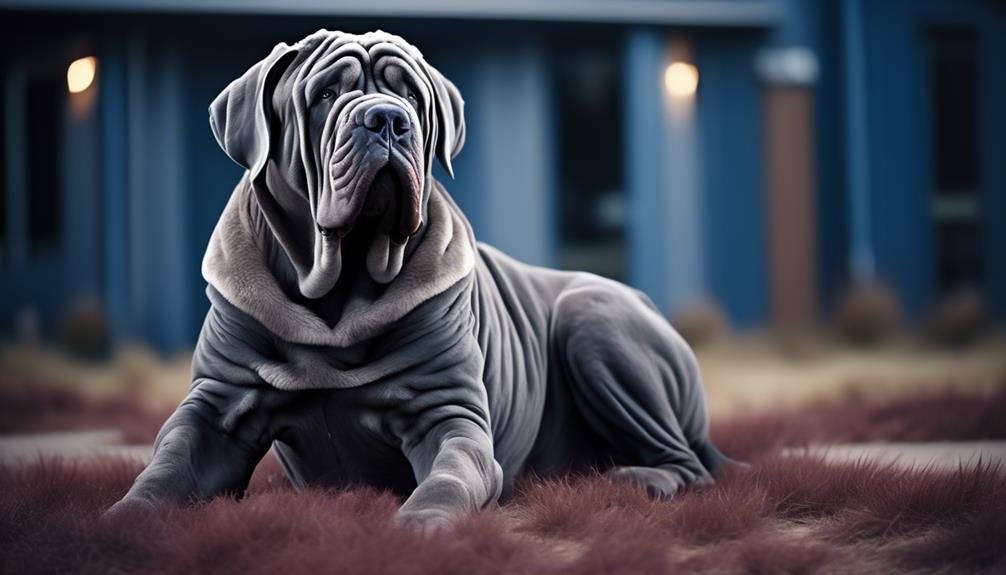
The Neapolitan Mastiff has a short, smooth, and dense coat. It's important to understand the characteristics of the Neapolitan Mastiff's coat in order to properly care for it. Here are three key features of the Neapolitan Mastiff's coat:
- Low Maintenance: The short coat of the Neapolitan Mastiff requires minimal grooming. Regular brushing will help to remove loose hair and keep the coat clean and healthy.
- Weather Resistant: The dense coat of the Neapolitan Mastiff provides protection against various weather conditions. It helps to keep the dog warm in cold weather and provides a barrier against rain and moisture.
- Shedding: Despite having a short coat, the Neapolitan Mastiff does shed. However, the shedding is relatively moderate compared to other breeds. Regular brushing can help to minimize shedding and keep the coat looking its best.
Understanding these characteristics of the Neapolitan Mastiff's coat will assist you in maintaining its health and appearance.
Adaptability to Apartment Living

Now let's shift our focus to the Neapolitan Mastiff's adaptability to apartment living. While the Neapolitan Mastiff is a large breed, it can surprisingly adapt well to living in an apartment. Size alone should not be the sole determinant when choosing a dog for an apartment. Consider the dog's energy level and activity needs. Prioritize qualities such as being quiet, low-energy, and well-behaved towards neighbors. The table below highlights some factors to consider when choosing a dog for apartment living:
| Factors to Consider | Neapolitan Mastiff |
|---|---|
| Size | Large |
| Energy Level | Low |
| Exercise Needs – Intensity | Low |
As you can see, the Neapolitan Mastiff's low energy level and exercise needs make it a suitable choice for apartment living. However, it's important to create a harmonious environment by considering your living space and the needs of your neighbors.
Factors to Consider When Choosing a Dog for an Apartment
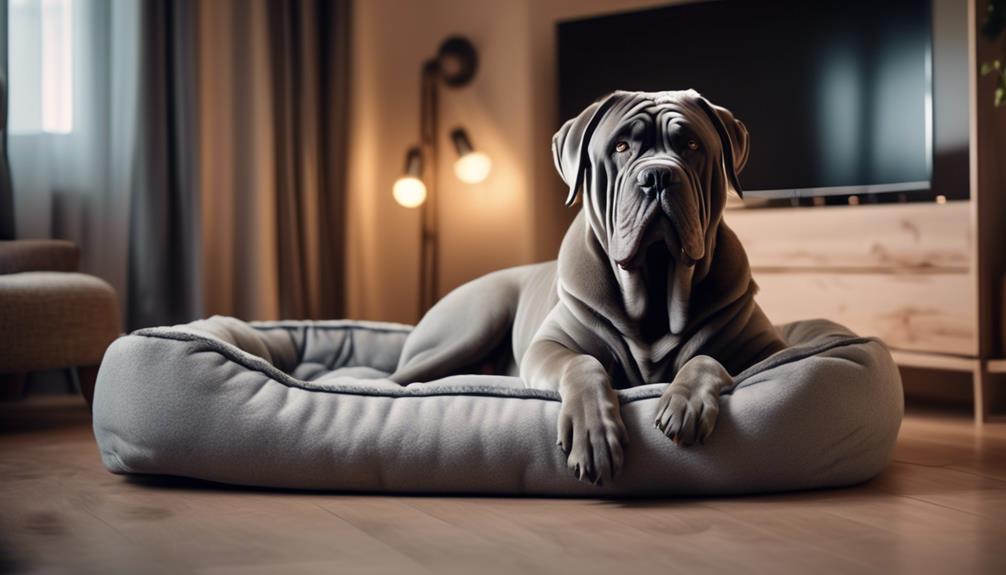
Consider the specific needs and characteristics of a dog before choosing one to live in your apartment. It's important to take into account factors that will contribute to a harmonious environment. Here are three key factors to consider when choosing a dog for an apartment:
- Energy level and exercise needs: Select a dog with a low energy level that will be content with moderate exercise. This will help prevent excessive barking or restlessness in a confined space.
- Temperament and behavior: Prioritize dogs that are known for being quiet, calm indoors, and well-mannered towards neighbors. Avoid breeds that have a tendency to bark excessively or have high prey drive.
- Size and living space: While size alone shouldn't be the sole determinant, consider the available living space in your apartment. Smaller dogs or breeds that adapt well to small spaces can thrive in apartments.
Affectionate and Protective Nature
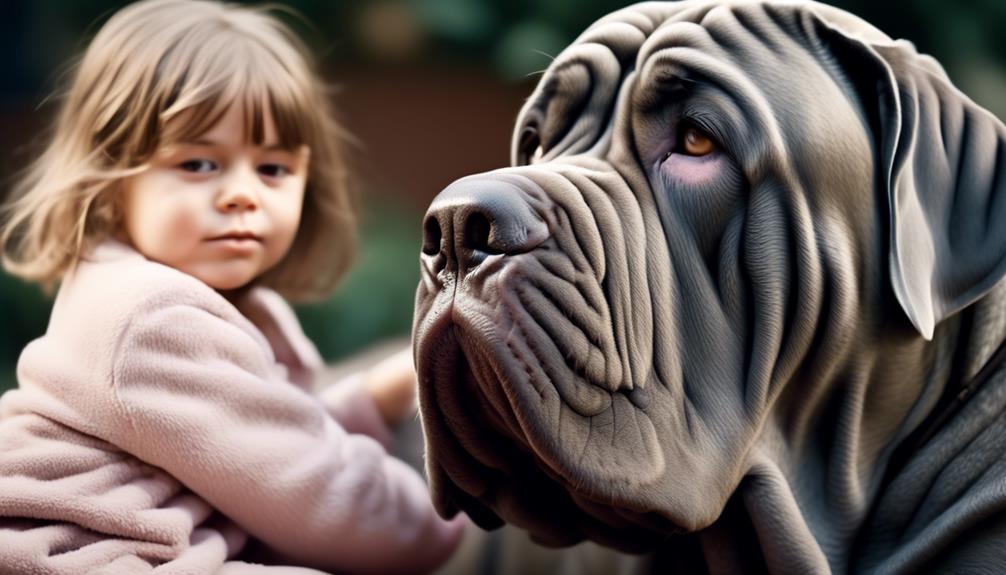
When choosing a dog for an apartment, it's important to consider their affectionate and protective nature. The Neapolitan Mastiff is known for being a loyal and protective breed, making them excellent companions for families. They are affectionate with their family members and are generally good with children. However, it is important to note that they may not be suitable for novice dog owners due to their strong protective instincts. To provide a deeper understanding of their behavior, here is a table highlighting some factors to consider in Neapolitan Mastiffs:
| Factors to Consider |
|---|
| Prey drive and hunting instincts |
| Tendency to bark or howl |
| Wanderlust potential |
| Exercise needs – energy level |
| Exercise needs – intensity |
Suitability for Families With Children
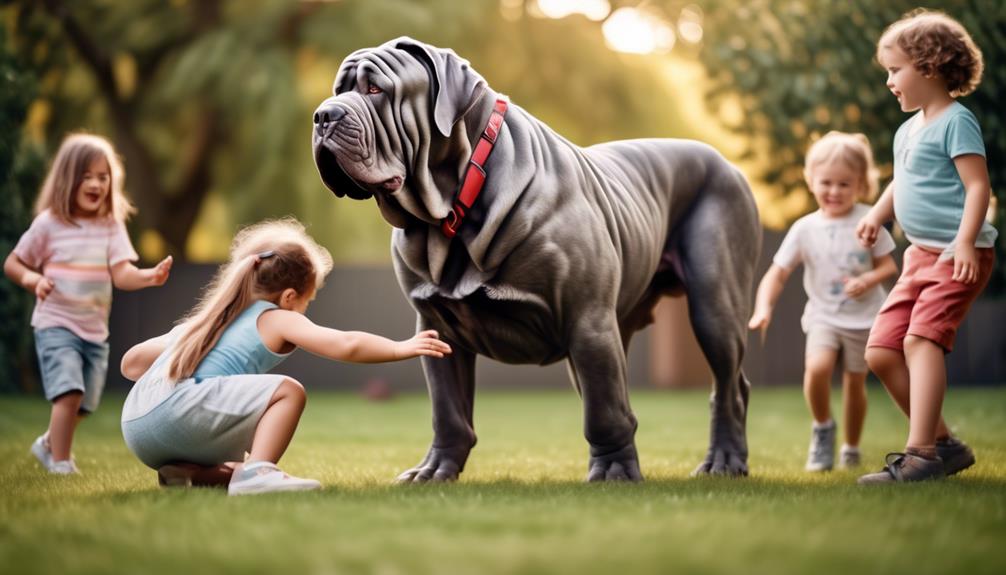
The Neapolitan Mastiff is an excellent choice for families with children due to their affectionate and protective nature. Here are three reasons why they're suited for families with kids:
- Gentle and Patient: Neapolitan Mastiffs are generally good with children. They have a calm and patient demeanor, making them tolerant of the unpredictable behavior of young ones.
- Protective Instincts: These dogs are fiercely loyal and protective of their families. They'll go to great lengths to ensure the safety of their loved ones, including children. Their protective nature can provide parents with peace of mind.
- Affectionate Companions: Neapolitan Mastiffs are known for their affectionate nature. They form strong bonds with their families, including children, and enjoy spending quality time with them. Their loving and gentle personality makes them wonderful companions for kids.
With their gentle nature, protective instincts, and affectionate disposition, Neapolitan Mastiffs can make a great addition to any family with children.
Considerations for Novice Dog Owners
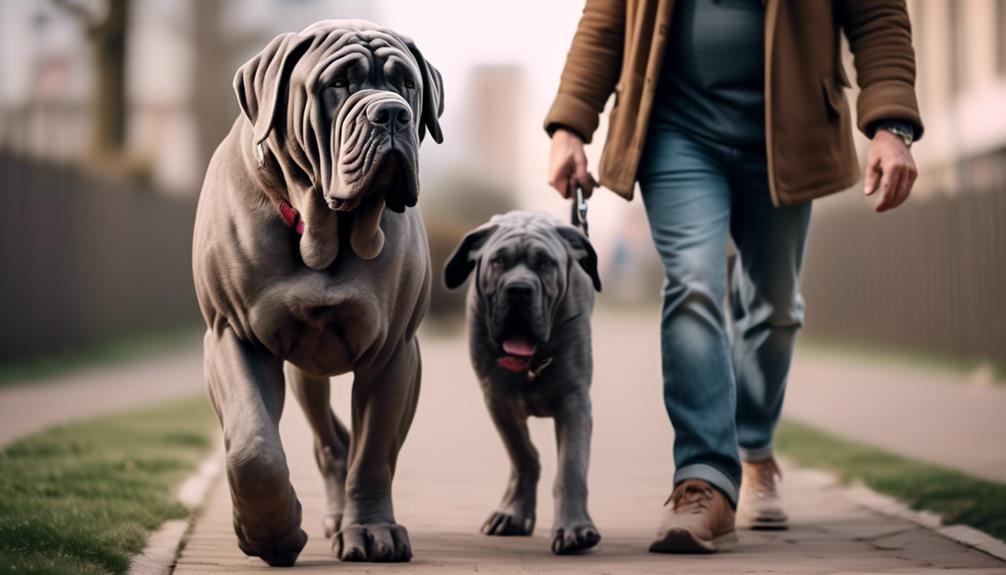
Novice dog owners may find it helpful to understand the unique considerations associated with owning a Neapolitan Mastiff. While this breed can be affectionate and loyal, it may not be suitable for inexperienced owners.
Neapolitan Mastiffs are known for their protective nature, which can sometimes lead to aggression if not properly managed and trained. Their large size and strength also require owners who are confident and able to handle them.
Additionally, Neapolitan Mastiffs have specific health needs, such as proper diet and exercise, regular grooming, and potential breed-related health issues. Novice owners should be prepared for the financial responsibility that comes with owning a large breed dog, including veterinary care and potential training expenses.
It's important for novice dog owners to thoroughly research and understand the breed's characteristics and needs before bringing a Neapolitan Mastiff into their home.
Behavioral Traits to Be Aware of
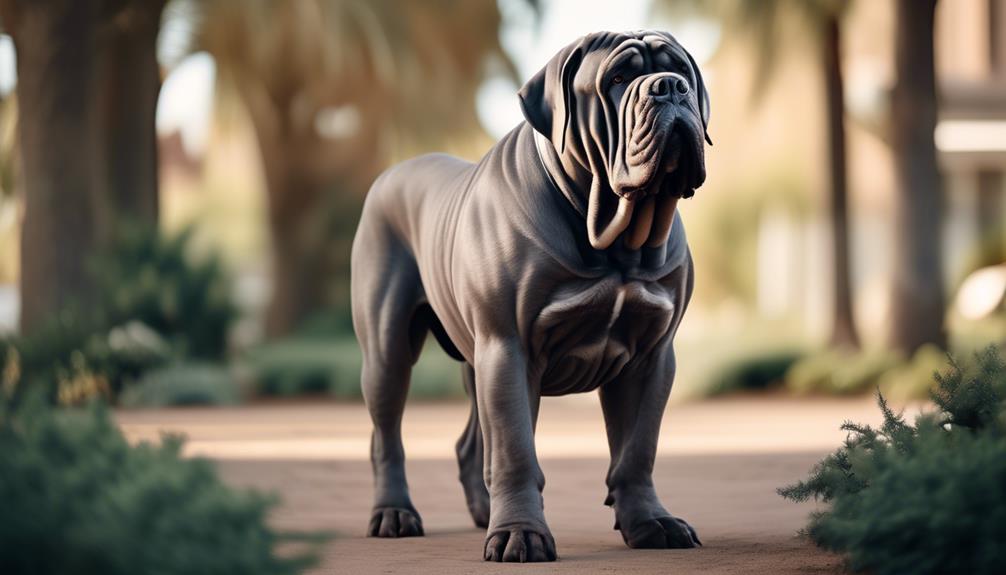
Be aware of certain behavioral traits in Neapolitan Mastiffs to ensure a harmonious and well-managed living environment. Here are three important traits to consider:
- Protective nature: Neapolitan Mastiffs are known for their loyalty and protective instincts towards their family. They can be wary of strangers and may exhibit guarding behaviors. Proper socialization and training from an early age are crucial to ensure they can distinguish between genuine threats and normal situations.
- Gentle giants: Despite their imposing size and protective nature, Neapolitan Mastiffs can also be gentle and loving companions. They're generally good with children and can be affectionate towards their family members. However, it's essential to supervise interactions between the dog and young children due to their large size.
- Independent streak: Neapolitan Mastiffs have an independent streak and may not be suitable for novice dog owners. They require firm and consistent training to establish boundaries and prevent any dominance issues. Early obedience training and socialization are vital to ensure they grow up to be well-behaved and well-adjusted dogs.
Health, Care, and Training Considerations
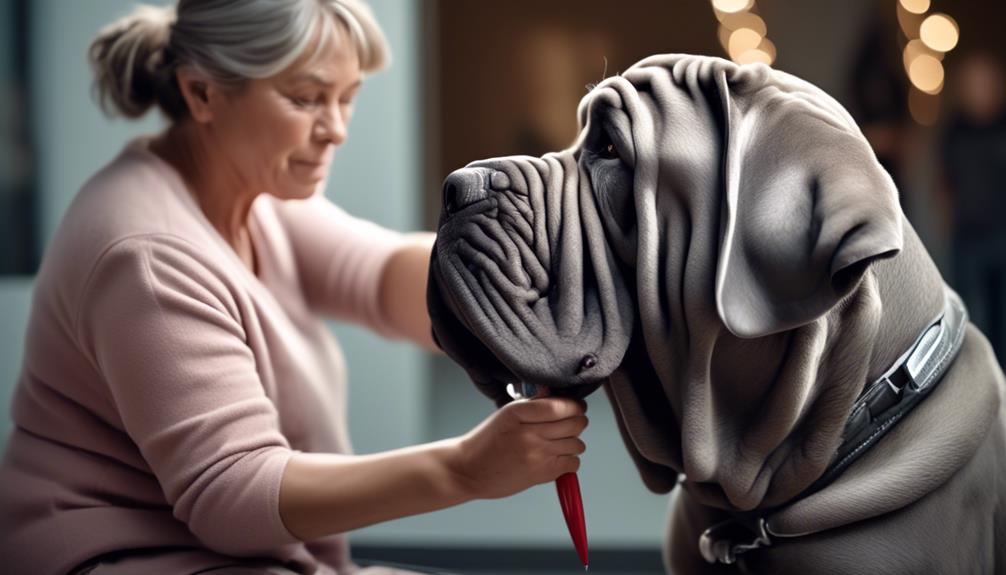
To ensure the well-being and proper development of your Neapolitan Mastiff, it's important to understand the health, care, and training considerations associated with this breed.
Neapolitan Mastiffs are prone to certain health issues, such as hip dysplasia, cherry eye, and bloat. Regular veterinary check-ups, a balanced diet, and sufficient exercise are crucial for maintaining their overall health.
Due to their large size, Neapolitan Mastiffs require a spacious living environment with a secure yard. They have a short, dense coat that requires minimal grooming, but their wrinkles need regular cleaning to prevent infections.
Training a Neapolitan Mastiff requires patience, consistency, and positive reinforcement methods. Early socialization is important to ensure they grow up to be well-rounded and obedient companions.
With proper care and training, your Neapolitan Mastiff can thrive and bring joy to your life.
Frequently Asked Questions
Are Neapolitan Mastiffs Prone to Separation Anxiety?
Yes, Neapolitan Mastiffs can be prone to separation anxiety. They are known to form strong bonds with their families and may become anxious when left alone for long periods of time.
How Much Exercise Does a Neapolitan Mastiff Need on a Daily Basis?
You don't need to provide the context of Neapolitan Mastiff Dog Breed Information & Characteristics. A Neapolitan Mastiff needs regular exercise to stay healthy. Aim for at least 30-60 minutes of physical activity each day, such as walks or playtime.
Do Neapolitan Mastiffs Have a Strong Prey Drive?
Yes, Neapolitan Mastiffs have a strong prey drive. It's important to be aware of this when considering them as a pet. Training and socialization can help manage their instincts and ensure a harmonious environment.
Can Neapolitan Mastiffs Be Trained to Be Off-Leash?
Yes, Neapolitan Mastiffs can be trained to be off-leash. With consistent training, positive reinforcement, and early socialization, you can teach them to respond reliably to commands and enjoy freedom while still being obedient.
Are Neapolitan Mastiffs Prone to Any Specific Health Issues?
Yes, Neapolitan Mastiffs are prone to certain health issues. It's important to be aware of potential problems such as hip dysplasia, heart conditions, and skin infections. Regular vet check-ups and proper care can help manage these issues.
What are the similarities and differences between Neapolitan Mastiffs and Mastiffs in terms of characteristics and traits?
Neapolitan Mastiffs and Mastiffs share some similarities in terms of being large, muscular, and powerful dogs with protective instincts. However, Neapolitan Mastiffs have loose, wrinkled skin and a more imposing appearance, while Mastiffs have a more square-shaped build. Both breeds are known for their loyalty and gentle nature. For more mastiff dog characteristics and information, consult a breeder or veterinarian.
Conclusion
In conclusion, the Neapolitan Mastiff is a versatile and adaptable breed that can thrive in apartment living as long as their exercise needs are met. Their size shouldn't be the sole determining factor when choosing a dog for an apartment.
With their affectionate, loyal, and protective nature, they make excellent companions for families with children. Whether you're a novice or experienced dog owner, the Neapolitan Mastiff is a breed worth considering.
Ensure to provide them with proper care, training, and attention to ensure their health and wellbeing.




